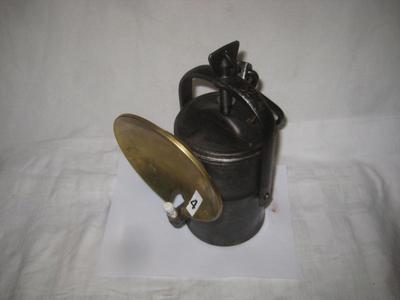National Museum of American History
National Museum of American History
National Museum of American History
National Museum of American History
National Museum of American History
National Museum of American History
National Museum of American History
The general design of carbide lamps was consistent across designers and manufacturers, with the differences often being improvements to the water-drip mechanism or gas feed. The similarity of lamps was an issue for Frederick Baldwin, who sued many of his competitors for patent infringement. The design of the carbide lamp consists of two chambersan upper chamber holding water and a lower chamber holding the calcium carbide.Acetylene gas is produced when water from the lamps upper level encounters the calcium carbidestored in the base via a dripping mechanism. The amount of water flowing into the calcium carbidecontainer can be controlled, with more water producing more gas and a bigger flame when the lamp is lit. The gas is funneled to the burner, where it is lit by a match or a built-in striker. Once the flame is lit, a reflector allows the miner to control the direction of the light.
American Art Museum and Portrait Gallery
National Museum of American History

Eliot Elisofon Photographic Archives, African Art
National Museum of American History
National Museum of American History
National Museum of American History
National Museum of American History
National Museum of American History
National Museum of American History
Air and Space Museum Udvar-Hazy Center
National Museum of American History
National Museum of American History
National Museum of American History
The carbide lamp consisted of several improvements to both the oil-wick lamp and candle as a means for lighting in non-ga搜索引擎优化us mines. The lamp produced no carbon monoxide, consumed less oxygen, gave a brighter 4-6 candlepower light, and had a higher light quality than the candles or oil-wick lamps it replaced. The carbide lamp had its problems as well. Average runtime in carbide cap lamps was only about four hours, necessitating a carbide refill mid-shift, which could leave the miner in darkness. The burner tip was also prone to clogging, and concussive blasts or winds inside the mine could extinguish the light as well.
National Museum of American History
The popularity of carbide mining lamps was shortlived, as electric battery powered lamps came into favor around 1918 due to their superior light, safety, and runtime, and had almost completely replaced carbide lamps by the 1930s.
National Museum of American History
National Museum of American History
National Museum of American History
Smithsonian Institution Building, the Castle
National Museum of American History
National Museum of American History
Carbide lamps are powered by the reaction of calcium carbide (CaC2) with water (H2O). This reaction produces acetylene gas (C2H2)which burns a clean, white flame. Acetylene gas was originally discovered by Edmund Davy in 1836, but commercial production of calcium carbide only became feasible due to the efforts of Thomas Wilson in 1894. Frederick Baldwin is credited with developing the first carbide mining lamp, holdingU.S. Patent number 656,874for an Acetylene Gas Lamp that was granted August 28, 1900. Commercial production of carbide mining lamps began soon after, and the collection in the Division of Work and Industry reflects a variety of carbide lamp designers and manufacturers includingBaldwinAuto-LiteGuys DropperShanklinDewar, andWolf. Carbide lamps came in different sizes for different uses, smaller lamps were cap lamps, larger lamps were hand lamps or hanging lamps.
Cooper Hewitt, Smithsonian Design Museum
National Museum of American History
National Museum of American History
National Museum of American History
National Museum of American History
National Museum of American History
National Museum of American History
National Museum of American History
National Museum of American History
National Museum of American History
National Museum of American History
Air and Space Museum Udvar-Hazy Center
National Museum of American History
Grant Wheats Story of Underground Lighting
National Museum of American History
National Museum of American History